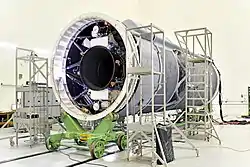CE-7.5
The CE-7.5 is a cryogenic rocket engine developed by the Indian Space Research Organisation to power the upper stage of its GSLV Mk-2 launch vehicle. The engine was developed as a part of the Cryogenic Upper Stage Project (CUSP). It replaced the KVD-1 (RD-56) Russian cryogenic engine that powered the upper stage of GSLV Mk-1.[3]
 The CUS15 upper stage of GSLV-F09 powered by the CE-7.5 engine at Stage Preparation Facility | |
| Country of origin | India |
|---|---|
| First flight | 15 April 2010 (failure) 5 January 2014 (success) |
| Designer | LPSC, Indian Space Research Organisation |
| Manufacturer | Hindustan Aeronautics Limited ISRO |
| Application | Upper-stage booster |
| Status | In use |
| Liquid-fuel engine | |
| Propellant | LOX / LH2[1] |
| Cycle | Fuel-rich staged combustion |
| Configuration | |
| Chamber | 1 |
| Performance | |
| Thrust, vacuum | 73.5 kN (16,500 lbf)[2] |
| Chamber pressure | 5.8 MPa (58 bar) / 7.5 MPa (75 bar) |
| Specific impulse, vacuum | 454 seconds (4.45 km/s) |
| Dimensions | |
| Length | 2.14 m (7.0 ft) |
| Diameter | 1.56 m (5.1 ft) |
| Dry weight | 435 kg |
| Used in | |
| Upper stage of GSLV Mk.II | |
Overview
CE-7.5 is a regeneratively-cooled, variable-thrust, fuel-rich staged combustion cycle rocket engine.[4][5]
Specifications
The specifications and key characteristics of the engine are:
- Operating Cycle – Staged combustion[6]
- Propellant Combination – LOX / LH2[7]
- Maximum thrust (Vacuum) – 73.55 kN[8]
- Operating Thrust Range (as demonstrated during GSLV Mk2 D5 flight) – 73.55 kN to 82 kN [2][9]
- Engine Specific Impulse - 454 ± 3 seconds (4.452 ± 0.029 km/s)[4][6]
- Engine Burn Duration (Nom) – 720 seconds[8]
- Propellant Mass – 12,800 kg[8]
- Two independent regulators: thrust control and mixture ratio control[7]
- Steering during thrust: provided by two gimballed steering engines[7]
Development
Indian Space Research Organisation (ISRO) formally started the Cryogenic Upper Stage Project in 1994.[10] The engine successfully completed the Flight Acceptance Hot Test in 2008,[6] and was integrated with propellant tanks, third-stage structures and associated feed lines for the first launch. The first flight attempt took place in April 2010 during the GSLV Mk.II D3/GSAT-3 mission. The engine ignited, but the ignition did not sustain as the Fuel Booster Turbo Pump (FBTP) shut down after reaching a speed of about 34,500 rpm 480 milliseconds after ignition, due to the FBTP being starved of Liquid Hydrogen (LH2).[2] On 27 March 2013 the engine was successfully tested under vacuum conditions. The engine performed as expected and was qualified to power the third stage of the GSLV Mk-2 rocket. On 5 January 2014 the cryogenic engine performed successfully and launched the GSAT-14 satellite in the GSLV-D5/GSAT-14 mission.[11][12]
Applications
CE-7.5 is being used in the third stage of ISRO's GSLV Mk.II rocket.[13]
References
- "Cryogenic engine test a big success, say ISRO officials". Indian Express. Retrieved 27 December 2013.
- "GSLV-D3". ISRO. Archived from the original on 16 April 2010. Retrieved 8 January 2014.
- Ramachandran, R. (22 January 2014). "Russian route". Frontline. Archived from the original on 24 October 2020. Retrieved 17 August 2021.
- "GSLV-D3 brochure" (PDF). ISRO. Archived from the original (PDF) on 7 February 2014.
- "GSLV MkIII, the next milestone". Frontline. 7 February 2014.
- "Flight Acceptance Hot Test Of Indigenous Cryogenic Engine Successful". ISRO. Archived from the original on 30 June 2016. Retrieved 8 January 2014.
- "Indigenous Cryogenic Upper Stage". Archived from the original on 6 August 2014. Retrieved 27 September 2014.
- "GSLV-D5". ISRO. Archived from the original on 6 October 2014. Retrieved 27 September 2014.
- "GSLV-D5 launch video – CE-7.5 thrust was uprated by 9.5% to 82 kN and then brought back to nominal thrust of 73.55 kN". Doordarshan National TV. Archived from the original on 21 December 2021.
- "How ISRO developed the indigenous cryogenic engine". The Economic Times.
- "Welcome to Indian Space Research Organisation - GSLV-D5/GSAT-14 Mission". Archived from the original on 4 January 2014. Retrieved 5 January 2014.
- "Indigenous Cryogenic Upper Stage Successfully Flight Tested On-board GSLV-D5". ISRO. Archived from the original on 8 January 2014. Retrieved 6 January 2014.
- "GSLV - Isro". Archived from the original on 4 September 2015. Retrieved 31 May 2016.

